-
 Bitcoin
Bitcoin $118400
0.47% -
 Ethereum
Ethereum $3836
2.20% -
 XRP
XRP $3.157
2.98% -
 Tether USDt
Tether USDt $0.9999
-0.03% -
 BNB
BNB $801.5
1.31% -
 Solana
Solana $180.9
2.07% -
 USDC
USDC $0.9999
-0.02% -
 Dogecoin
Dogecoin $0.2225
2.50% -
 TRON
TRON $0.3285
-1.02% -
 Cardano
Cardano $0.7789
2.60% -
 Hyperliquid
Hyperliquid $43.60
2.39% -
 Sui
Sui $3.892
4.41% -
 Stellar
Stellar $0.4229
3.34% -
 Chainlink
Chainlink $18.01
3.98% -
 Hedera
Hedera $0.2745
6.77% -
 Bitcoin Cash
Bitcoin Cash $582.3
3.38% -
 Avalanche
Avalanche $23.77
1.04% -
 Ethena USDe
Ethena USDe $1.001
0.01% -
 Toncoin
Toncoin $3.493
3.59% -
 Litecoin
Litecoin $110.0
2.48% -
 UNUS SED LEO
UNUS SED LEO $8.936
-0.37% -
 Shiba Inu
Shiba Inu $0.00001304
2.49% -
 Uniswap
Uniswap $9.999
1.09% -
 Polkadot
Polkadot $3.897
3.26% -
 Monero
Monero $308.6
-0.83% -
 Dai
Dai $0.9999
-0.01% -
 Bitget Token
Bitget Token $4.504
-0.04% -
 Pepe
Pepe $0.00001154
2.95% -
 Cronos
Cronos $0.1471
3.06% -
 Ethena
Ethena $0.6691
19.53%
MACD zero axis golden cross + step back on the five-day line without breaking
A MACD zero-axis golden cross followed by a pullback to the 5-day EMA signals a strong bullish entry when price bounces with rising volume.
Jul 29, 2025 at 06:42 pm
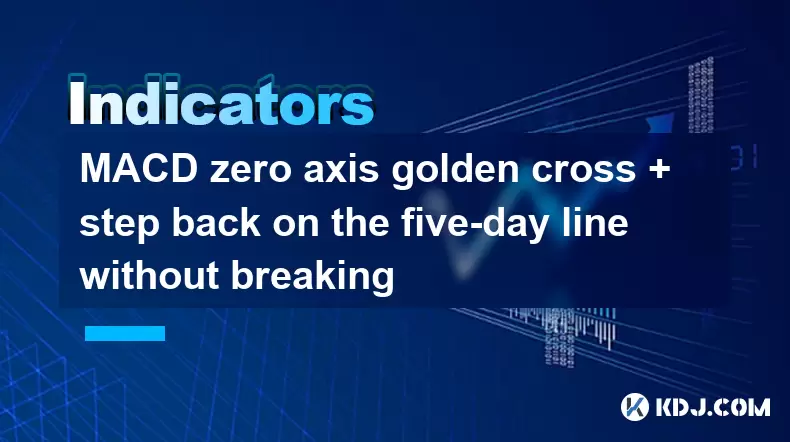
Understanding the MACD Zero Axis Golden Cross
The MACD (Moving Average Convergence Divergence) is a momentum indicator widely used in cryptocurrency technical analysis to identify potential trend reversals and entry points. A golden cross on the zero axis occurs when the MACD line (the difference between the 12-period and 26-period Exponential Moving Averages) crosses above the signal line (9-period EMA of the MACD line) precisely at or near the zero level. This specific condition is significant because it indicates that short-term momentum is not only surpassing longer-term momentum but also that the overall trend is shifting from bearish to bullish.
When the MACD line crosses above the signal line at the zero axis, it suggests that buying pressure is gaining control after a period of consolidation or downtrend. Traders interpret this as a strong signal, especially when confirmed by volume and price action. The zero axis acts as a psychological and technical threshold — crossing above it means the average price in the short term has overtaken the long-term average, reinforcing the bullish case.
What Does "Step Back on the Five-Day Line" Mean?
After a bullish signal such as a MACD zero axis golden cross, price often experiences a pullback to test previous resistance levels that have now turned into support. The "five-day line" refers to the 5-day Exponential Moving Average (EMA), a commonly watched short-term trend indicator in crypto trading due to the market’s 24/7 nature. A "step back" means the price retraces toward this EMA but does not close below it.
This behavior confirms strength in the ongoing uptrend. When price touches or slightly dips into the 5-day EMA without breaking it decisively, it shows that buyers are still in control and are stepping in to support the price. This consolidation phase allows late entrants to join the trend with reduced risk. The key is that the candlestick close remains above the 5-day EMA, which maintains the integrity of the bullish structure.
How to Identify the Pattern on a Crypto Chart
To apply this strategy effectively on a cryptocurrency chart, follow these steps:
- Open a trading platform such as TradingView or Binance and select a cryptocurrency pair like BTC/USDT or ETH/USDT.
- Apply the MACD indicator with default settings (12, 26, 9).
- Add the 5-day EMA to the price chart.
- Scan for instances where the MACD line crosses above the signal line near the zero axis.
- Observe whether, after the cross, the price pulls back and retests the 5-day EMA.
- Confirm that the candlesticks do not close below the 5-day EMA during the retest.
For example, on a 4-hour chart of SOL/USDT, you might notice the MACD lines intersecting just above the zero line. Following this, price rises but then pulls back over the next few candles. If those candles touch the 5-day EMA and bounce without closing below it, the pattern is confirmed. This combination increases the probability of a sustained upward move.
Setting Up Entry and Exit Points
Executing a trade based on this setup requires precision in timing and risk management. Consider the following approach:
- Entry: Place a buy order when the price bounces off the 5-day EMA after the MACD golden cross. Use a limit order slightly above the EMA to avoid premature execution.
- Stop-loss: Set the stop-loss just below the lowest point of the pullback or beneath the 5-day EMA, allowing a small buffer to avoid being stopped out by market noise.
- Take-profit: Use a risk-reward ratio of at least 1:2. For instance, if your stop-loss is 3% below entry, aim for a 6% gain. Alternatively, trail the profit using the 5-day EMA as a dynamic support.
Volume confirmation enhances reliability. A rising volume during the bounce from the 5-day EMA supports the validity of the move. Traders can also use RSI (Relative Strength Index) to ensure the asset isn’t overbought — an RSI below 70 during the pullback suggests room for upward movement.
Backtesting the Strategy on Historical Data
To validate this strategy, traders should backtest it across multiple crypto assets and timeframes. Here’s how:
- Select historical data for a cryptocurrency like ADA/USDT over a 3-month period.
- Manually mark all instances where the MACD golden cross occurred near the zero axis.
- For each signal, check if price subsequently pulled back to the 5-day EMA without breaking it.
- Record the outcome: Did price rise at least 5% after the bounce?
- Calculate the win rate and average return per trade.
Using Python with libraries like pandas and ta-lib, automate the detection:
import pandas as pd
import talibLoad OHLCV data
data = pd.read_csv('ADA_USDT_4h.csv')
data['macd'], data['macd_signal'], _ = talib.MACD(data['close'])
data['ema_5'] = talib.EMA(data['close'], timeperiod=5)
Find MACD zero-axis golden cross
golden_cross = (data['macd'] > data['macd_signal']) & (data['macd'].shift(1) <= data['macd_signal'].shift(1))
near_zero = (data['macd'] > -0.001) & (data['macd'] < 0.001)
Pullback to 5-day EMA
pullback = (data['low'] <= data['ema_5']) & (data['close'] > data['ema_5'])
This script identifies potential setups. Analyze the results to assess consistency across bull and consolidation phases.
Frequently Asked Questions
What timeframes work best for this MACD and 5-day EMA strategy?
The 4-hour and daily charts are most effective. Shorter timeframes like 15-minute generate too many false signals due to crypto volatility. The 4-hour chart balances signal quality and trade frequency, while the daily chart suits swing traders.
Can this strategy be used during sideways markets?
This setup is less reliable in range-bound markets where the MACD oscillates around zero without clear direction. The golden cross must occur after a downtrend or consolidation to carry significance. In sideways phases, MACD crossovers may fail to produce follow-through.
How do I adjust the 5-day EMA for different cryptocurrencies?
The 5-day EMA works across most major cryptos due to similar volatility profiles. For highly volatile altcoins, consider using a 5-period EMA on a 1-hour chart instead of daily. Always test adjustments in a demo environment before live trading.
Does the volume matter in confirming this pattern?
Yes, rising volume during the bounce from the 5-day EMA adds confirmation. Low volume during the retest suggests weak participation and increases the risk of failure. Use volume indicators to filter out low-confidence signals.
Disclaimer:info@kdj.com
The information provided is not trading advice. kdj.com does not assume any responsibility for any investments made based on the information provided in this article. Cryptocurrencies are highly volatile and it is highly recommended that you invest with caution after thorough research!
If you believe that the content used on this website infringes your copyright, please contact us immediately (info@kdj.com) and we will delete it promptly.
- Pudgy Penguins Price Prediction: Buying Opportunity or Insider Dump?
- 2025-07-31 18:50:35
- Penny Coin Power: Unearthing 20x Potential in Undervalued Crypto
- 2025-07-31 20:10:14
- Shrapnel, GalaChain, and China Gaming: A New Frontier
- 2025-07-31 19:10:35
- Mutuum Finance, Bitcoin, and Market Analysis: Decoding the Latest Trends
- 2025-07-31 19:30:13
- Dogecoin Howl: Bullish Signals and Analyst Bites – Is the Meme Coin Ready to Pounce?
- 2025-07-31 18:30:16
- Decoding Crypto Presales, Ethereum's Role, and Navigating a Tricky Altcoin Season
- 2025-07-31 18:30:16
Related knowledge
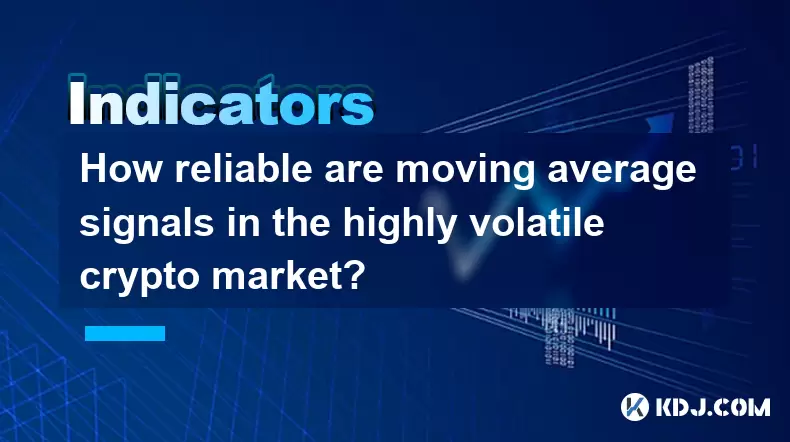
How reliable are moving average signals in the highly volatile crypto market?
Jul 31,2025 at 08:36pm
Understanding Moving Averages in Cryptocurrency TradingMoving averages (MAs) are among the most widely used technical indicators in the cryptocurrency...

Why do moving averages lag and what is the impact of this lag in crypto trading?
Jul 31,2025 at 08:07pm
Understanding the Concept of Moving Averages in Crypto TradingMoving averages are among the most widely used technical indicators in cryptocurrency tr...
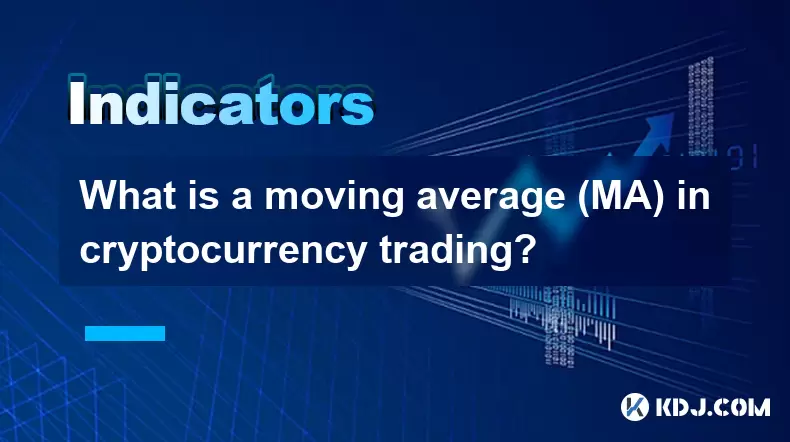
What is a moving average (MA) in cryptocurrency trading?
Jul 31,2025 at 06:30pm
Understanding the Concept of Moving Average (MA)A moving average (MA) is a widely used technical analysis tool in cryptocurrency trading that helps sm...
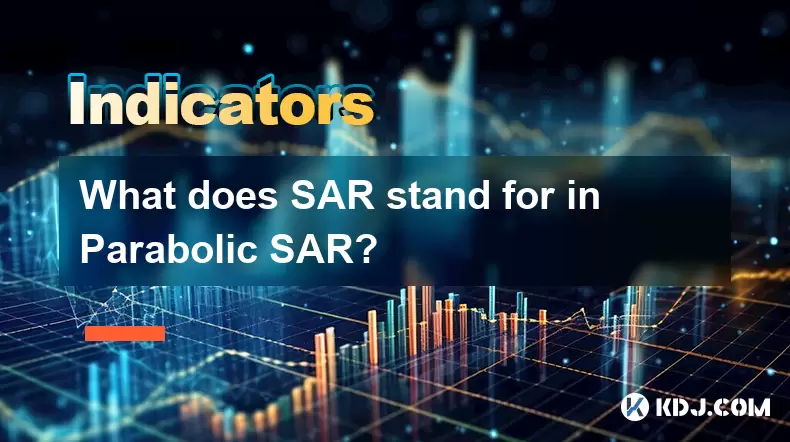
What does SAR stand for in Parabolic SAR?
Jul 31,2025 at 06:49pm
Understanding the Meaning of SAR in Parabolic SARIn the context of technical analysis in the cryptocurrency market, SAR stands for 'Stop and Reverse' ...
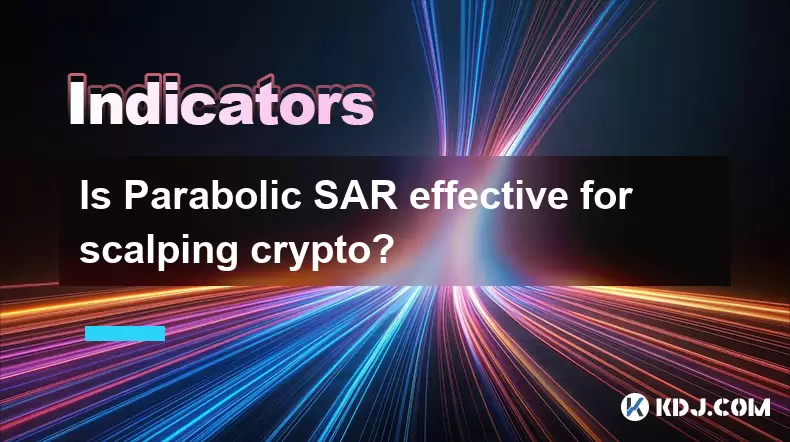
Is Parabolic SAR effective for scalping crypto?
Jul 31,2025 at 08:29pm
Understanding Parabolic SAR in Cryptocurrency TradingThe Parabolic SAR (Stop and Reverse) is a technical indicator developed by J. Welles Wilder, prim...

Is Parabolic SAR suitable for swing trading crypto?
Jul 31,2025 at 05:29pm
Understanding Parabolic SAR in Cryptocurrency TradingThe Parabolic SAR (Stop and Reverse) is a technical indicator developed by J. Welles Wilder that ...

How reliable are moving average signals in the highly volatile crypto market?
Jul 31,2025 at 08:36pm
Understanding Moving Averages in Cryptocurrency TradingMoving averages (MAs) are among the most widely used technical indicators in the cryptocurrency...

Why do moving averages lag and what is the impact of this lag in crypto trading?
Jul 31,2025 at 08:07pm
Understanding the Concept of Moving Averages in Crypto TradingMoving averages are among the most widely used technical indicators in cryptocurrency tr...

What is a moving average (MA) in cryptocurrency trading?
Jul 31,2025 at 06:30pm
Understanding the Concept of Moving Average (MA)A moving average (MA) is a widely used technical analysis tool in cryptocurrency trading that helps sm...

What does SAR stand for in Parabolic SAR?
Jul 31,2025 at 06:49pm
Understanding the Meaning of SAR in Parabolic SARIn the context of technical analysis in the cryptocurrency market, SAR stands for 'Stop and Reverse' ...

Is Parabolic SAR effective for scalping crypto?
Jul 31,2025 at 08:29pm
Understanding Parabolic SAR in Cryptocurrency TradingThe Parabolic SAR (Stop and Reverse) is a technical indicator developed by J. Welles Wilder, prim...

Is Parabolic SAR suitable for swing trading crypto?
Jul 31,2025 at 05:29pm
Understanding Parabolic SAR in Cryptocurrency TradingThe Parabolic SAR (Stop and Reverse) is a technical indicator developed by J. Welles Wilder that ...
See all articles

























































































